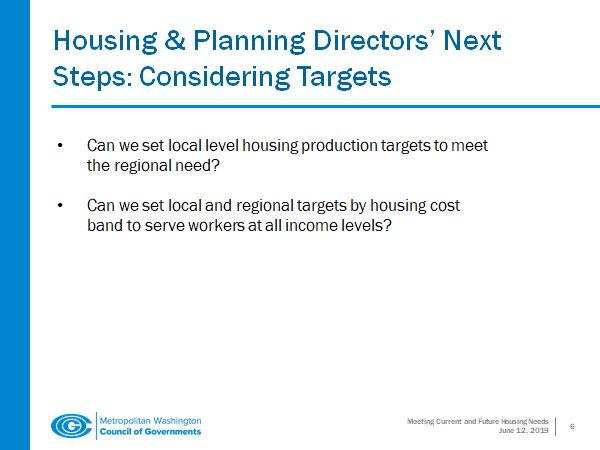As the region grows and adds new housing to align with this growth, local leaders will also need to ensure new housing is sized and priced affordably for those who will need it.
Currently, too few housing units are affordable for the lowest to middle income households.
In a presentation to the COG Board of Directors in June, the Urban Institute revealed that many area households are already considered “housing cost-burdened,” meaning a family spends more than 3o percent of its income on housing. Those in the lowest to middle household income bands are the most burdened. Occupations in these bands include service workers, nursing attendants, paramedics, firefighters, and graphic designers. Regional growth is expected to intensify this challenge further.
This research is a preview of the Urban Institute’s Regional Housing Framework, a project sponsored by the Greater Washington Partnership. The full report is expected soon.
Under the direction of the COG Board, local housing and planning directors have been studying what it would take to increase housing beyond what is currently forecast to provide enough housing for the region’s growing workforce. This includes considering the amount, accessibility, and affordability of additional units.
According to Urban Institute, many more housing units will be needed from the lowest to middle cost bands to accommodate both expected and additional growth.
“What we’re talking about here is a mix in which about 40 percent of the additional units are in the middle cost bands, and only about 22 percent are in the highest cost bands,” said Margery Turner, Urban Institute Senior Vice President for Program Planning and Management. “A bit under 40 percent are in the lowest cost bands, which definitely…requires public subsidy to be feasible.”
According to Margery Turner, Urban Institute Senior Vice President for Program Planning and Management, the organization projects that many more housing units will be needed in the lowest to middle cost bands to accommodate both expected and additional growth. A good mix might be one in which the majority, about 40 percent, of the additional units are priced in middle cost bands (housing costs of $1,300-$2,499 per month), just under 40 percent in the lowest cost bands ($0-$1,299 per month), and 22 percent in the highest cost bands ($2,500-$3,500 per month), she said.
From a policy perspective, Urban Institute suggested a better housing cost balance could be achieved by preserving existing affordable housing and protecting renters and home buyers from discrimination and displacement, in addition to producing more units across the income spectrum.
The Urban Institute research may help answer questions about affordability raised by the COG Housing Initiative. Already, COG identified—and local planning and housing directors confirmed—that the region needs to increase the number of housing units by over 100,000 homes beyond what is planned between now and 2045 to accommodate growth. This spring, COG worked with local planners to determine that Activity Centers, locations identified as ideal for growth in metropolitan Washington, and areas near high capacity transit could accommodate this additional housing.

Polly Donaldson, COG Housing Directors Advisory Committee Co-Chair and District of Columbia Department of Housing and Community Development Director, explained that the next step for the COG Housing Initiative is to work with officials on the board to determine whether the region can set targets to meet its housing production and affordability needs by 2045. The conversation will resume in July at the COG Annual Leadership Retreat.
MORE:
Report: More than 2M area families live in unaffordable housing
Report lays out new mandate to meet housing needs in Greater Washington